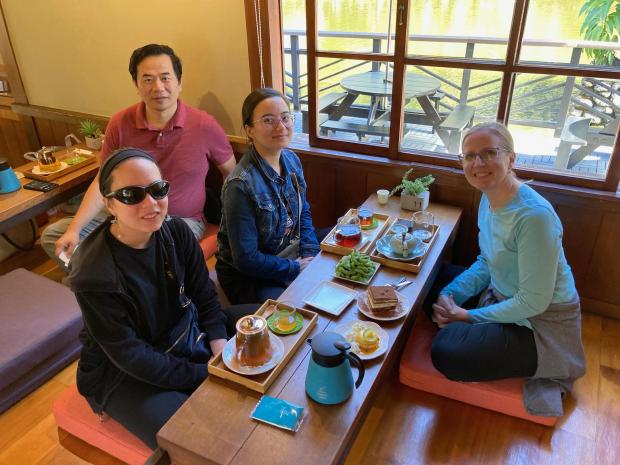Joyce Owens was a Chicago mixed-media artist who worked as a graphics coordinator at WBBM-Ch. 2 and taught for 19 years at Chicago State University.
“She was constantly creating artwork, and she really enlivened the lives of everybody around her,” “ said retired Channel 2 political reporter Derrick Blakley, a longtime friend.
Owens, 76, died at her Lincoln Park home Oct. 8 after suffering a stroke and a hip fracture while battling Alzheimer’s disease, said her husband of 41 years, former Channel 2 director of community affairs Monroe Anderson.
She was born Joyce Florence Owens in Philadelphia. Her mother, Eloise Owens, was an opera singer. Owens received a bachelor’s degree in art from Howard University, where she was art editor of the university’s literary magazine, and then got master of fine arts degree in painting from Yale University.
With work in art hard to come by, Owens took a job as a producer at WCAU, a TV station in Philadelphia, then followed a boyfriend to Chicago, where she signed on in 1974 as a graphics coordinator for news at Channel 2.
“Television is, quite obviously, a visual medium, one where what you show is as key to communication as what you say,” said former Channel 2 executive producer Donna LaPietra, who joined the station a few months after Owens. “I quickly bonded with Joyce … who had to bring visual life and understanding for those times when there is no film or tape rolling — when an anchor needed just the right photo or image over the shoulder.”
LaPietra said Owens “brought her smile and gracious kindness into what could often be the brashness of deadline mania in the newsroom.”
“She was the calm in the swirl of a day’s events,” LaPietra said. “She could always make sense of it all. She had thoughtfulness that went layers deep in a business that could too often skim the surface.”
Owens left WBBM in 1981 to devote herself full time to her artwork. Over the next four decades, Owens explored a variety of themes in her artwork, including race and racism, largely through figurative painting. However, Owens also used wood and paper, and also produced masks.
“She was a woman who was not afraid to deal with issues of race, gender, equality and inequality in her work,” said retired WMAQ-Ch. 5 reporter Renee Ferguson, who set Owens up with Anderson. “She put it on canvas and she did it brilliantly and she did it fearlessly. She cared about race and she cared about Black women, and she understood that how we are shown is how we are told.”
Owens’ paintings were honored in the Museum of Science Industry’s 1988 and 1996 “Black Creativity” juried art exhibitions, and her work was displayed locally at places such as the Wood Street Gallery and the Hyde Park Art Center, and globally in locations such as NATO headquarters in Brussels, the Philadelphia Museum of Art and the University of Pennsylvania Museum. She was part of Sapphire & Crystals, a Black women’s artists’ collective formed in 1987, and she was tapped to paint then-Chicago Mayor Eugene Sawyer, for a portrait that was presented to him on his birthday in 1988.
“My paintings inhabit who I am, she wrote on her blog in 2010. “I articulate my concerns for my community around racism, sexism and fairness by painting my responses to these issues.”
Ferguson noted that Owens’ work could be simultaneously figurative and abstract.
“Her life was like that, so if you had a really deep conversation with her, it wasn’t going to be anything simple,” Ferguson said. “It was going to be obvious but not so obvious, and it was going to be clean but pretty dirty. And her work also expressed optimism — you’ll see flowers in everything she does, and you’ll see people lifting each other up.”
Six of Owens’ paintings are displayed in various U.S. State Department locations, including embassies, as part of the State Department’s Art in Embassies program.
“It is with a heavy heart that we bid farewell to the talented Joyce Owens, whose vibrant artwork is displayed globally … including in my own official residence,” U.S. Ambassador to the U.N. Linda Thomas-Greenfield tweeted after Owens’ death.
Owens curated various exhibitions. In 2006, Chicago State appointed her curator of its galleries program, and in 2013, she curated “Diasporal Rhythms: A 10-Year Love Affair With Collecting Art of the African Diaspora,” an exhibition of 57 works at the Logan Center.
Owens in 1996 was hired to be a full-time professor of painting and drawing at Chicago State, where she taught until retiring in 2015.
“She was able to bring her level of expertise and artistic vision to students who often didn’t have exposure to that kind of artistic knowledge,” Blakley said.
Long after they had been co-workers, LaPietra said she and Owens had remained close through lengthy phone calls.
“Joyce and I would often spend an hour, talking about her family and her work, but mostly about how to create a richer civic and arts community in Chicago — serious stuff,” LaPietra said. “But it’s her laughter that still echoes in my head.”
A first marriage ended in divorce. Owens also is survived by two sons, Scott and Kyle; a sister, Yvonne Jones; and two grandchildren.
A celebration of life event is planned for this summer.
Goldsborough is a freelance reporter.




